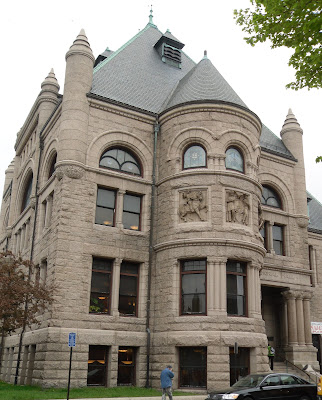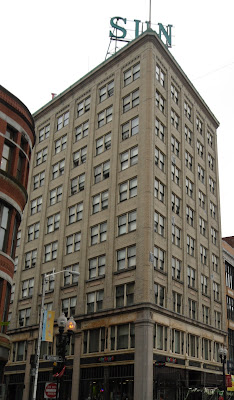The leaflet 'Jack Kerouac's Lowell: Where the Road Begins: Map & Guide to Jack Kerouac's Hometown, Lowell, Massachusetts, Lowell, Featuring Sites Referenced in His Books from the Multi-Volume Legend of Dulouz', published by the Lowell Historical Society, has been of great use to me in creating this post, and indeed in discovering Lowell.
Jack Kerouac's Grave
The Jack Kerouac Story
The first home of Jack Kerouac (1922-69).
'It was in Centralville I was born, in Pawtucketville saw Doctor Sax. Across the wide basin to the hill - on Lupine Road, March 1922, at five o'clock in the afternoon of a red-all-over suppertime, as drowsily beers were tapped in Moody and Lakeview saloons and the river rushed with her cargoes of ice over reddened slick rocks, and on the shore the reeds swayed among mattresses and cast-off boots of Time, and lazily pieces of snow dropped plunk from bagging branches of black thorny oily pine in their thaw, and beneath the wet snows of the hillside receiving the sun's lost rays the melts of winter mixed with roars of Merrimac - I was born. Bloody rooftop. Strange deed. All eyes I came hearing the river's red; I remember that afternoon, I perceived it through beads hanging in a door and through lace curtains and glass of a universal sad lost redness of mortal damnation ... the snow was melting. The snake was coiled in the hill not in my heart.'
Jack Kerouac, Doctor Sax (1959)
Jack Kerouac was indeed born in March 1922, on 9 Lupine Road, Centralville, which is very close to Pawtucketville to the west, and is north of the Merrimack River, Lowell. His house is now in two appartments. His parents were French Canadians who met in Nashua, New Hampshire, before moving to Lowell (which is pronounced as one long, lovingly drawled syllable.)
Kerouac attended Lowell High School, on Kirk Street, downtown Lowell, and was influenced by Whitman, Saroyan, Wolfe, and Thoreau. He won a football scholarship to Columbia University, New York City, and his novel Maggie Cassidy is set in his senior year here.
The Pollard Memorial Library, Merrimack Street, was constructed in 1893, and Kerouac wanted to read every book here.
St Jean Baptiste Church on Merrimack Street was built in 1888 for French-Canadian immigrants, many of whom lived in Little Canada, the northernmost part of the Acre district of Lowell, which faces the northern shore of the Merrimack River.
The influence of French Canadians who moved to this former mill town is evident from many French words seen on trading premises, and is definitely not a mere tourist symbol: away from downtown Lowell, there's a 'Truc Salon', which is a hairdresser's, and a Jeanne d'Arc insurance company, to give but two out of many possible examples.
The Boott Cotton Mills on John Street existed between 1835 to 1954, and are mentioned in Kerouac's work. This building now functions as a museum.*
Kerouac briefly worked for the Lowell Sun as a sports reporter.
The elaborate clock by the Sun building is also mentioned.
The Kerouac Commemorative, Kerouac Park, Bridge Street/French Street, was conceived by the Lowell Historic Preservation Commission, which chose Ben Woitena to design it in 1988.
The design features eight polished granite slabs that are inscribed from quotations from five books of Kerouac's that draw on his early experiences of Lowell. A plaque explains:
'This work is a tribute to Jack Kerouac, voice of the Beat Generation. Kerouac's spirited novels and poems chronicled his life and adventures in Lowell and on the road. The design is based on a mandala, a pattern which symbolizes the universe. The cross-shaped path and circles refer to Kerouac's Christian and Buddhist beliefs.'
One side of the columns is a quotation from The Scripture of Golden Eternity:
'Stare deep into the world before you as if it were
the void: innumerable holy ghosts, buddhies,
the void: innumerable holy ghosts, buddhies,
and savior gods there hide, smiling. All the
atoms emitting light inside wavehood, there is
no personal separation of any of it. A hummingbird
can come into a house and a hawk will not: so rest
and be assured. While looking for the light, you
may suddenly be devoured by the darkness
and find the true light.'
Scripture 22
Another side contains the beginning and the end of Kerouac's most famous - and most probably most significant - work, On the Road (1957), which is modeled on his experiences with the legendary Neal Cassady (1926-68).
'I first met Dean not long after my wife and I split up. I had just gotten over a serious illness that I won't bother to talk about, except that it had something to do with the miserably weary split-up and my feeling that everything was dead. With the coming of Dean Moriarty began the part of my life you could call my life on the road. Before that I'd often dreamed of going West to see the country, always vaguely planning and never taking off. Dean is the perfect guy for the road because he actually was born on the road, when his parents were passing through Salt Lake City in 1926, in a jalopy, on their way to Los Angeles. First reports of him came to me through Chad King, who'd shown me a few letters from him written in a New Mexico reform school. I was tremendously interested in the letters because they so naively and sweetly asked Chad to teach him all about Nietzsche and all the wonderful intellectual things that Chad knew. At one point Carlo and I talked about the letters and wondered if we would ever meet the strange Dean Moriarty. This is all far back, when Dean was not the way he is today, when he was a young jailkid shrouded in mystery. Then news came that Dean was out of reform school and was coming to New York for the first time; also there was talk that he had just married a girl called Marylou…'
'So in America when the sun goes down and I sit on the old broken-down river pier watching the long, long skies over New Jersey and sense all that raw land that rolls in one unbelievable huge bulge over to the West Coast, and all that road going, and all the people dreaming in the immensity of it, and in Iowa I know by now the children must be crying in the land where they let the children cry, and tonight the stars'll be out, and don't you know that God is Pooh Bear? the evening star must be drooping and shedding her sparkler dims on the prairie, which is just before the coming of complete night that blesses the earth, darkens all the rivers, cups the peaks and folds the final shore in, and nobody, nobody knows what's going to happen to anybody besides the forlorn rags of growing old, I think of Dean Moriarty, I even think of Old Dean Moriarty the father we never found, I think of Dean Moriarty.'
*Unfortunately, at the time of my visit to Lowell (I hadn't read Kristin Bierfelt's The North Shore Literary Trail: From Bradstreet's Andover to Hawthorne's Salem (Charleston, SC: The History Press, 2009)) I wasn't aware of its other famous writer - Lucy Larcom (1824-94). As well as the Kerouac Commemorative, there is also a Lucy Larcom Park, which has some sculptures with lines from some of the poems of Larcom, who was born in Beverley and moved to Lowell, later working at Boott Mills. She edited a paper from 1840 - sponsored by the mill - called Lowell Offering, which contained articles and poems written by the mill girls. Her autobiography, A New England Girlhood: Outlined from Memory (Boston: Houghton, Mifflin, 1889) is here.
My other Kerouac links:.
–––––––––––––––––––––––––––––––––––
*Unfortunately, at the time of my visit to Lowell (I hadn't read Kristin Bierfelt's The North Shore Literary Trail: From Bradstreet's Andover to Hawthorne's Salem (Charleston, SC: The History Press, 2009)) I wasn't aware of its other famous writer - Lucy Larcom (1824-94). As well as the Kerouac Commemorative, there is also a Lucy Larcom Park, which has some sculptures with lines from some of the poems of Larcom, who was born in Beverley and moved to Lowell, later working at Boott Mills. She edited a paper from 1840 - sponsored by the mill - called Lowell Offering, which contained articles and poems written by the mill girls. Her autobiography, A New England Girlhood: Outlined from Memory (Boston: Houghton, Mifflin, 1889) is here.
My other Kerouac links:.
Jack Kerouac's Grave
The Jack Kerouac Story

















No comments:
Post a Comment